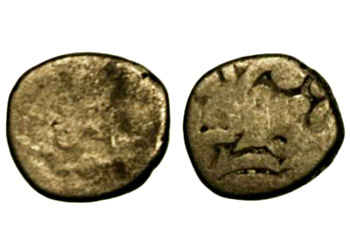 Dramma is held to be the name of a billon (silver or copper alloy) coin of the class called `Indo-Sassanian`. It is called so because of the demonstrable evolution of its design elements from the broad, thin coinage of the Sassanian emperors of Iran (fifth century AD). The influence of this coinage was extended by the Hun invaders of northern and western India (sixth century AD), whose coin types had been adopted, by early Gurjara kingdoms in the Sind-Rajasthan borderlands (seventh century AD). The coin has on the obverse, a head in right profile, with the late Brahmi or proto-Devanagari legend. The reverse has portions of a fire altar flanked by attendants, sometimes without legend. The mean weight of 145 surviving specimens is 3.81 g. These generally show advanced wear, and the original weight standard of manufacture was likely higher.
Dramma is held to be the name of a billon (silver or copper alloy) coin of the class called `Indo-Sassanian`. It is called so because of the demonstrable evolution of its design elements from the broad, thin coinage of the Sassanian emperors of Iran (fifth century AD). The influence of this coinage was extended by the Hun invaders of northern and western India (sixth century AD), whose coin types had been adopted, by early Gurjara kingdoms in the Sind-Rajasthan borderlands (seventh century AD). The coin has on the obverse, a head in right profile, with the late Brahmi or proto-Devanagari legend. The reverse has portions of a fire altar flanked by attendants, sometimes without legend. The mean weight of 145 surviving specimens is 3.81 g. These generally show advanced wear, and the original weight standard of manufacture was likely higher.
Analysis reveals that the silver content for the Vigrahapala Dramma of 1.83 g each. These areas are not necessarily the only ones where these coins have been discovered, but are the areas indicated in reports where the inspecting authorities have bothered to differentiate these particular types from the general classification `Indo-Sassanian`. However, the concentrated circulation of Vigrahapala dramas does not include the Ganga basin. Their period of circulation, as attested by the Siyadoni inscription, is at least as late as AD 948 - 949. So they were accepted in the Gurjara-Pratihara dominions. The date and agent of manufacture is rather more elusive.
Some observers think them to have been issued by the Pala kings of Bengal. Vigrahapala Dramma establishes the existence of a flourishing currency system at the foundation of the Gurjara-Pratihara dominions. This also places their period of manufacture during the reigns of Bhoja`s predecessors. Logical system dictates two possibilities; firstly that the coinage was issued by the successive protagonists for possession of madhyadesa in the eighth century: Indrayudha of Kannauj, Dharmapala of Bengal, Vatsaraja Pratihara of Ujjain, or any of their feudatories and allies, throughout the region of the Ganga basin. Secondly, the coinage was issued by the Pratiharas in Malwa that is eastern Rajasthan homeland prior to conquest of North India, and carried into the latter area with their advancing frontiers. So it is possible that the Pratiharas found a prototype Vigrahapala Dramma coinage already in use in madhyadesa at the time of its inclusion in their empire.






